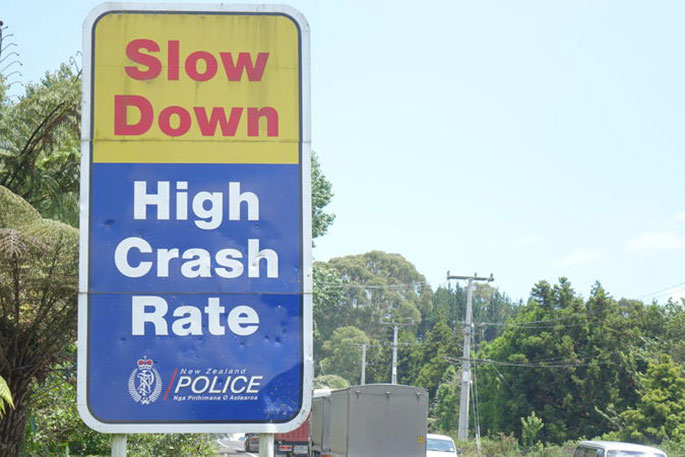The government is proposing a new road safety strategy called Road to Zero, aiming to cut road deaths by 40 per cent in the next decade.
The strategy will be put out for consultation today.
Associate Transport Minister Julie Anne Genter says the strategy will follow Sweden's Vision Zero strategy which seeks to eliminate road deaths.
"The government has made road safety a top priority and that has informed the development of this strategy.
"But we didn't just want to say it's a priority, we want a strategy backed up by evidence based action that's actually going to deliver a sustained and meaningful reduction in deaths and serious injuries on our roads.
"We know that no New Zealander wants or deserves to lose a loved one on the road."
Julie-Anne says the aim of a 40 percent reduction in road deaths is long term, and won't involve short term goals for reducing road death.
"Over the period of the 10 years that the strategy is in place, we're expecting that it will save 750 lives, and thousands of serious injuries."
The road toll in 2018 was 377.
If the new road safety strategy is implemented and is successful, that figure will drop to 226 or fewer in 2030, a reduction of 151 deaths.
Focus on roads
Julie-Anne says the key focus of the strategy is improving roading infrastructure, but not in the manner that the previous government had done.
The National-led government focused on Roads of National Significance, a number of motorways and expressways throughout the country.
The new strategy will seek to improve upon existing roads, rather than build new ones.
The government is aiming to improve the safety on more than 1500 kilometres of road over the next three years, at a cost of $1.4 billion.
Julie-Anne says the improvements will include building median barriers and side barriers, adding rumble strips, and making other safety upgrades.
It won't just be State Highways getting improvements, but rural roads as well.
"We're taking a very balanced approach.
"Most of the deaths, about 70 percent, have been on rural roads, which had been neglected by the previous government.
"So there will be a need to take a look at safe and appropriate speeds, particularly in those communities who are really calling for it, and on parts of the network where an infrastructure upgrade may not be able to happen in the next five to ten years.
 Associate Transport Minister Julie Anne Genter Photo: RNZ / Rebekah Parsons-King.
Associate Transport Minister Julie Anne Genter Photo: RNZ / Rebekah Parsons-King."It'll be a balance between targeting the most dangerous roads for a safer speed, but also making a significant investment in infrastructure to make roads safer, with things like median barriers and side barriers."
Rules will be changed to make it easier for councils to change local speed limits, while speed in front of schools will also be up for debate.
The speed outside urban schools could be reduced to 30km/h across the country, or 60km/h in front of rural schools.
Drivers
Sweden's Vision Zero approach, which New Zealand will replicate, assumes that drivers make mistakes regardless of the quality of the driver.
Humans, it assumes, are flawed and will make errors.
As a result, the strategy will take the driver out of the equation and try to make things safe regardless of inevitable mistakes and crashes, limiting the damage.
Despite that, the government will review driver licensing.
"We will be doing a full review of the licensing system.
"There may be some improvements that can be made.
"But again, as I always come back to, the thing that is going to be the most effective according to the evidence, is the infrastructure and the enforcement."
Cars
The government will also review the Warrant of Fitness and Certificate of Fitness systems, which haven't had a thorough review for two decades.
Julie-Anne says the process of vehicle inspections will be looked at, and whether modern safety systems in cars should be reviewed as part of the car testing.
She said the technology that can be added to cars now, like ABS braking and Electronic Stability Control, both of which are compulsory in new car imports from next year, could be added to.
RNZ reported earlier this month that certain unsafe cars could be banned based on new and used car safety ratings.
But Julie-Anne says that suggestion, made by an advisory group to the road safety strategy, would be confusing for consumers.
Instead, by 2022 new cars imported into the country may be required to have stricter safety standards.
They would roll out later in the decade for used cars imported to New Zealand.
Policing and speed cameras
Police will get more funding as part of a new strategy, which could lead to more dedicated road policing and an increase in safety cameras.
"If we are going to achieve our target, if we adopt the target of 40 percent, then there will be a need for increased investment in enforcement.
"Some of that will be automated, and some of that will be police having a role to play in improving safety on our roads."
More police and more cameras doesn't mean more money generated in fines, however.
Julie-Anne hopes people won't be fined by static speed cameras, or new point to point cameras, if they are added to the network.
Compliance was the end game, and she said there will also be a review of the penalties given to drivers caught by a camera or a police officer.
Asked if that could mean smaller fines and larger demerit points, Julie-Anne says it could.
If evidence suggests the threat of losing a licence makes drivers more sensible than large fines, she said that is the model the government would pursue.
"It's not about making money. In an ideal world, we wouldn't generate a cent from fines."
The new road safety strategy is available to view online at the Ministry of Transport website.
The consultation period will run for four weeks, closing on 14 August.



8 comments
Another farce
Posted on 17-07-2019 07:39 | By Angels
Reducing the speed limits will NOT reduce the deaths. No one is listening. The slow drivers will drive even slower and still back up traffic and cause more problems than enough. We are not targeting the causes of the accidents. Frustrated drivers making mistakes. But the driver causing the disruption continue. No police action. Now let’s slow down the country, economy etc, then in another 4-5 years we may look at the problem. Police not ticketing the slow drivers. We need to drive with lights on.
Suicide Barriers
Posted on 17-07-2019 08:12 | By First Responder
I love those side barriers. Flat tyre or break down, they stop you from pulling over too far to the left, keeping 1/2 the vehicle on the road. Sitting duck to be rear ended, let alone being run over while you change a RH tyre. Great idea.
M. Mouse
Posted on 17-07-2019 09:13 | By M. Mouse
That is a nice story but if you don't educate the driver's how to behave on the roads and driving to the conditions you can spend what you want but it won't work. Let's start with not texting and driving Stop for orange lights don't acculturate but actual stop that seems to be a big issue for most of the driver's in NZ. Indicate correctly on a roundabout. I think you need to have proper set up driving schools who actually teach those simple things and teach the upcoming generation. And stop that mum or dad can teach you how to drive because that's where it go,s absolutely wrong bad habits being passed on.
Yes, another farce
Posted on 17-07-2019 10:56 | By The Professor
I completely agree with "Angels". Reducing the speed limit is NOT the answer. During peak times, speed limits cannot be achieved......nowhere near, but there are still accidents. It all comes down to the Kiwi driver I'm afraid - they need to be taught how to drive properly and need to change their attitudes towards other drivers. The difference in this story is the fact that Sweden has better drivers with better attitudes. Start with those qualities first then see if the roads need making safer....I doubt it though. There is nothing wrong with the existing roads or speed limits.....it's the idiots who can't drive a vehicle. If limits are going to be reduced, then I say go for variable speed limits so that speeds can be adjusted when traffic volumes and therefore the risks, are higher. Cameras = revenue!!!
Avr
Posted on 17-07-2019 14:13 | By Anton
Adopt the rule from Europe by three lanes trucks are not allowed in the third lane, which causing traffic jams. I agree wholeheartedly with M. Mouse. Learn people to drive only with driving schools. Not mum or dad who are bad drivers themselves. Indicating is shocking nobody seems to know the proper way,
lights on
Posted on 17-07-2019 14:34 | By kiwigirl41
It would help if all drivers would drive with their car headlights on at all times...the idiots who continue to drive in bad driving conditions just add to the problem
Experience
Posted on 17-07-2019 14:45 | By hapukafin
Genter, how many miles have you driven to justify the comments you have made.I agree with most of the othe three comments.I still drive a 1980s car its as safe as anything with no fancy gadgets.Get your ideas away from speed and road conditions.Take SH2 it use to be 100kph with many passing bays,it is now 70,78,90 and a small amount of 100 and you keep saying its a bad road causing accidents with modern cars.Concentrate your energy as a minister to improve driver training,more rigorous driving tests,hold a L license to a higher age,limit engine/power size over this period of time as its done with motor cycle,and heavier penalty for phone users.Get drivers attitude right before allowing them on the road.Now you can take the amulance away from the bottom of the cliff.
Phones
Posted on 17-07-2019 23:40 | By Peaches
In my option mobile phones are the biggest danger on the roads today, you see hundreds of people talking and texting while driving, $80 fines will never stop this happening and then you also get the person to pay the fine. I feel if you are caught more than twice the phone should be confiscated and crushed, lossing a $1000 phone is going to hit hard and stop this behavior.
Leave a Comment
You must be logged in to make a comment.